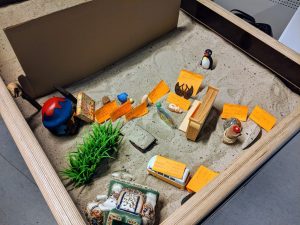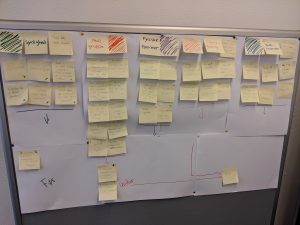Ane Marie’s House, located in Vrensted, was built in 1941 and was originally a foundation for unmarried women or widows from the area. Today, Ane Marie’s House is owned by Hjørring Municipality. Until the fall of 2018, a private kindergarten has rented the building from the municipality, but the kindergarten is now closed and the house is empty.
A group of passionate locals now wish to preserve the historically and architecturally beautiful building and provide it with new content. The idea is to use the house to convey and enliven the cultural heritage of village life that exists within and around the Ane Marie House. Preferably in such a way that provides relevance to the present in order to create experiences and knowledge through it.
Therefore, our task is to create a vibrant and authentic 1920s living room in the house, with the aim of telling and communicating the village’s cultural heritage. This must be done through the use of digital experience design, which in the best way communicates stories of old-time personalities and enthusiasts, local anchoring, genealogy etc. The dissemination will be done in an innovative and different way, but with great respect for the history and architecture of the house.
Members of the team:
- Elin Mølgaard Mathiasen (Interactive Digitale Media)
- Emilie Blangstrup Dahl (Experience Design)
- Julie Juhl Pedersen (Experience Design)
- Marc Ulrik Andersen (Experience Design)
- Martha Szlachetka Bomhelt (Interactive Digital Media)
- Michael Dahl Pasciak (Interactive Digital Media)
Concept video
Our final concept is developed around a bose-shoulder headset, where all the sound will come from. The voices in the shoulder speakers change, depending on which department you are in, in the living room. Another supporting element in the concept, is bits censors, which registers when guests are nearby.
When you walk around, different sounds will occur. A bornholmer clock starts ticking when you get near it. You can hear a watchmaker working in the background. A radio that plays 1920s music when you get to it. You can change channel on it too. When opening drawers, you can find elements of the story you hear. There is a picture that is moving, but the sound always comes from the shoulder speaker.
When you enter the room at the beginning, there is a screen where you see Anders Olesen in full figure, who stands and welcomes the guests and gives them a brief explanation of how the visit to Ane Marie’s House will proceed. He speaks both Danish, English and German, whichever you choose.
What make this solution a good idea, is that it caters to our target group who are 50 years old or above. In addition, it is also possible to use this solution if you have impaired hearing, because you don’t need to have earplugs in your ears to listen, the device is just placed on your shoulders. You are surrounded by sound, where you have your ears free and at the same time fully aware of your surroundings.
At the same time we don’t remove the interaction between people, since you’re still able talk together, and at the same time you don’t disturb each other. It is also easy to implement and can be scaled up and down exactly as you wish. You can remove and add different elements.
For example, the seasons can be changed, with Christmas decorations during the Christmas months, pumpkins and thrill for Halloween. Likewise, this solution does not need on-site staffing.
The Design Process
During the workshop there is a close interaction between teaching and practical work, which means that we are presented with methods and tools that we will immediately apply in practice.
Week 1: Observation & analysis – who are the users and what is the problem?
The workshop started with an introduction to U-CrAc as an innovation process and agility in design. At the same time, we were presented to our case, Ane Marie’s House and met with our case partner from Bunker 43 for the first time. During this meeting we were given answers to the first questions and got established a basis for a common starting point.
Then fieldwork was taught as a method of data collection, including observation, which ended up being the approach we primarily used. Next we applied what we learned in practice, and did our data collection on three different museums in Aalborg; Lindholm Høje, Gråbrødrekloster Museum and Utzon Center and also took an inspirational trip to Den Gamle By in Aarhus. During the observation at the various locations, we had a special focus on the dissemination of elements included in the museums’ exhibitions, including digital elements. We also focused on observing how the 50+ population uses digital tools in exhibitions.
The same day, we visited Ane Marie’s House in Vrensted, where we were shown around the house, observing and interviewing the volunteers who want to give the house new content. The data collection gave us a number of findings, insights and challenges that we could work on.
Next, we had a teaching lesson in material storytelling, in order to transform our field observations and data into manageable inputs that support the further work of developing a concept. We used the sandbox method, which made it is possible to pass on our insights, ideas and own knowledge to others, by letting them manifest themselves in the concerned artifacts. The reflection opened up an abstract User Journey Map based on the artifacts.
Week 2: Synthesis & Realization – from initiating ideas to concept proposals
Based on the sandbox workshop and our data collection, we were able to set up four innovation tracks, based on the challenges we faced in transforming our field observations and data into a concept. We presented these issues/tracks to our case partner, which are the following:
– How to extend the experience?
– How are most stories integrated into the space we have? (layered content)
– How to create a red thread?
– How to move people with the experience?
During the meeting with our case partner, we also presented our key findings, in order to negotiate the final direction in which our concept was to be developed. At the end of the meeting, we agreed to combine single elements from each innovation track in order to create a new and final track. (indsæt billede af vores endelige juletræ).
Here we ended up with “feeling after the visit” as the first priority, “storytelling” as the second, “the red thread” as the third, and “bringing home the experience” as the fourth.
This final innovation track has become the framework for what we believe is most important to integrate into our final concept. On this basis, we created four different directions that the final concept could possibly take; Puzzle/quiz, an interactive authentic living room, an audio experience and VR-glasses as an experience.
For each direction, we sketched a short film, to test the directions in practice and see if we would run into some wicked problems. Based on this, we chose our final concept based on the audio experience. We conceptualized this in a concept video, in order to show and explain our idea and the thoughts behind, to make it possible for externals to understand.
Sketches of the concept
Mystery/Quiz
The visitor has to solve clues while learning stories about the individuals who have made themselves known to the local community in Vrensted.
The interactive authentic living room
The visitor is told the story of the old 1920s style, through screens and interactive objects, without destroying authenticity with eye-catching technology.
The sound experience
The sound experience where the house takes the guest on a journey through the Vrensted history, where the guest is handed a bose-shoulder headset.
VR-glasses
The guest is told the story through VR glasses, which are either brought through the room or set at specific locations. Example: “A time travel on the couch”.



